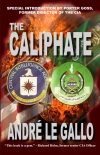The Red Cell by André Gallo (best books to read non fiction .TXT) 📗

- Author: André Gallo
Book online «The Red Cell by André Gallo (best books to read non fiction .TXT) 📗». Author André Gallo
“So I take it we’re not talking bombs here?” The speaker was General Philip Seymour, the assistant to the chairman of the joint chiefs, a usually taciturn three-star from Missouri.
“No, sir. We think we have a way of decaying their enrichment process...”
“You ‘think?’ Bombing them is not so uncertain,” Seymour interrupted.
“You will be more positive when you hear the details,” LaFont urged, turning toward Marshall.
“Instead of bombs, we want to encourage the core of the enrichment process, the centrifuges, to self-destruct,” Marshall said, looking around the table. “The IRGC, the Iranian Revolutionary Guards, built a power station about ten miles from the Fordow Enrichment Center near Qom. Its only purpose is to provide electricity to Fordow. The normal electric grid is much too unreliable, too inconsistent, for the exacting requirements of the centrifuges.”
“So we bomb the power station?” Seymour asked.
“No, we capture the station computer’s regulating software, and we control the speed at which the centrifuges rotate. Too fast and they fly apart. It will take at least a year to replace 3000 centrifuges.”
“So, this a repeat of Olympic Games and STUXNET, the joint program we ran with the Israelis?”
The puzzled looks around the table prompted Marshall to add, “By capture, I mean control, which we can probably do without stepping on Iranian soil.”
“I’m no lawyer,” Steve said, “but, at this point, we’re not at war with Iran, and I can say with confidence the president will veto any action requiring boots on the ground, even if it’s only a commando team.”
Marshall was struck by Steve’s statement. It was the first time he was faced by his son in his White House role, and he had mixed feelings. Though the comment might provide ammunition for anyone against the idea, Marshall was proud Steve was speaking on behalf of the president.
“What about the other 65 targets on our list?” Seymour asked.
“The level of destruction is more of a political issue and not a topic for our group today,” Steve said. “But isn’t the objective to stop the nuclear program with as little political blowback as possible? If it can be done with minimum collateral damage, that’s a major plus for this option.”
One of the TV screens on the wall suddenly came to life, and President Adam Tremaine, thin and professorial, appeared.
“Thérèse, I just learned about your meeting, so let me give your group my parameters on stopping Iran from getting a bomb. First, I believe becoming a nuclear power will remain on the Iranian agenda no matter what we do. But we can keep slowing their progress, to the point where they will decide by themselves the effort is no longer worthwhile. What I’m saying is I do not want to carpet-bomb Iran. I’m looking for surgery on one or more key nodes that will stop their progress for another year or two. With minimum collateral damage.”
Marshall turned sharply toward the president thinking after another year or two it will be somebody else’s problem.
“Mr. President, my Red Cell has the plan you describe, and we’ll get on your calendar,” LaFont replied.
As they left the conference room LaFont invited Steve and Marshall to her office, whose large windows overlooked the verdant CIA campus. Before they all sat down at a round table, she said, “It was too early today to surface another operation I have in mind. I have a more immediate task for your Red Cell. Based on what nearly happened to Steve, I want an extraordinary rendition of General Ghassem Yosemani, Commander of Iran’s Quds Force.”
4. Damascus
Ghassem Yosemani, the Yas Air Boeing 737’s only passenger, gazed toward the South, mindful he was within easy striking distance of both the Americans and the Israelis. After a circuitous route from Tehran to avoid surveillance by the U.S. and Israeli air forces, the aircraft, bought secondhand from Venezuela, circled over Damascus, the oldest continuously inhabited city in the world.
General Yosemani hated Iran’s pariah status, which forced him to sneak into a country that historically and by rights still ought to have no more than provincial status in a Persian empire. Most galling was having to use old American equipment. He yearned for the day when Persia regained its rightful status among the world’s great powers. Instead of masquerading in a collarless civilian shirt, the gold wreaths on his black shoulder boards would shout to all he commanded the elite Quds Force, Iran’s intelligence and action arm.
He saw himself as Persia’s satrap for the Middle East, responsible for Hamas in Gaza, and Hizballah in Lebanon. Now, Syria’s regime needed his help to handle the rebels. He was the tip of the Persian spear.
Jamil Hassan, head of Idarat al Mukhabarat al Jawiyya, Syria’s Air Force Intelligence, welcomed him at the airport. On their way to Mukhabarat headquarters on Tahrir Square, Yosemani directed him to make a stop in Sayyida Zainab to pray at the shrine. Compared to the Quds Force commander, whose meticulously trimmed, salt-and-pepper beard and penetrating gaze conveyed an almost biblical authority, Hassan was shorter and rounder with a bushy white mustache. Yosemani knew the man had begun his climb up the ladder during the Hama massacre in 1982, when the Syrian intelligence and military had killed over 20,000 citizens. He was not fooled by Hassan’s jocular manner.
The serious bargaining didn’t begin until they were sitting in the Syrian’s spacious office under a large photo of Bashar al-Assad, the Syrian president whose fate, according to western observers, was to appear before a tribunal for crimes against humanity.
“I have good news for





Comments (0)